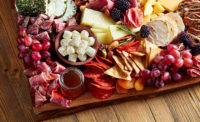From All Directions
By Andy Hanacek,
Executive Editor
Executive Editor
The poultry industry continues to fend off challenge after challenge, and it hasn’t gotten any easier
It’s hard to relax when it seems that every time you turn around, you are the target of something new. That, in effect, has been the poultry industry’s predicament throughout the past year.
Whether it has been fears of an avian-flu outbreak, the constant fight against pathogens, or old Mother Nature, it seems that poultry processors have been on a wide smattering of hit lists lately. Yet, the industry has been fighting the good fight and keeping one step ahead of those challengers.
With avian influenza (AI) rearing its ugly head around the world, those in the poultry industry have continued to try to ease the concerns and fears of consumers who believe an outbreak in the United States is only a matter of time.
But that has not been easy. The American consumer has been bombarded with stories of AI, the conditions overseas, the possibilities of a human strain of the disease, and a host of speculation over the future. Will it come to America? Will it make the jump to humans? What if it does either of those things? Are we talking about a pandemic or just a huge loss for the poultry industry?
Yet, through it all, the message from the poultry industry has been loud and clear: An outbreak in the United States is unlikely, and the poultry industry has much more on which to focus than avian influenza.
Since the Sept. 11 terrorist attacks, the demand for improved security across the nation has been at an all-time high. Pundits and experts have combed over seemingly every possibility for future terrorist attacks, and have attempted to corner and quash any loopholes in the system, including those in the food industry.
Biosecurity has been a major concern lately among food processors, and poultry processors have not been excluded from that group. Poultry companies continue to examine and alter their methods in all facets of the process, from farm to table, doing their share to keep the food supply safer than it had ever been. To note, many in the industry believe that all these added measures and levels of biosecurity should keep consumers comfortable that AI will not be a major problem in the United States either.
Yet, the issue of biosecurity has become such a prime issue that the U.S. Department of Agriculture’s Animal and Plant Health Inspection Service (APHIS) has begun a program called “Biosecurity for the Birds,” a national campaign to promote avian health through biosecurity.
The Web site, which can be found in the Animal Health section of www.aphis.usda.gov, asks poultry processors to look for the signs that a bird is sick, report sick birds, and practice “backyard biosecurity.”
Practicing good backyard biosecurity, according to the site, means, in very simple terms, “don’t bring germs to your birds, and don’t bring your birds to germs.” The site goes on to tell readers that good biosecurity measures don’t have to be cumbersome or expensive, and it offers simple tips, such as restricting access to birds and cleaning shoes, clothes, and any modes of transport that comes in contact with the birds, that processors can incorporate into their own programs.
Keeping poultry products safe from intentional tampering, however, is only half the battle in making the food supply safe. Efforts continue, of course, in the battle to stunt the prevalence of pathogens in poultry products.
The industry is awaiting 2004 data from the U.S. Department of Agriculture’s Food Safety and Inspection Service (FSIS) offices, but the most recent data from FSIS shows that Salmonella eradication has proven to be difficult.
Data from 2003 showed a rise (from 2002 numbers) in the prevalence of Salmonella in three poultry categories: Broilers, Ground Chicken, and Ground Turkey. Of more than 6,400 tested samples in the Broilers category, 12.8 percent were found to contain Salmonella. In the Ground Chicken category, 35.5 percent of nearly 300 samples were contaminated, and in the Ground Turkey sector, just more than 1,000 samples were tested, with 25.4 percent failing the test.
Many in the industry believe that processors can and will learn from past pathogen eradication efforts, such as those geared toward eliminating E.coli from ground beef, an effort that has resulted in significant drops in the prevalence of that pathogen every year since the FSIS began testing in 1998.
As if the poultry industry didn’t have enough on its plate, Mother Nature decided that 2005 would be the year that she wreaked havoc upon much of the United States’ Gulf South region, with hurricanes Katrina and Rita roaring ashore.
The losses were widespread and total for thousands of Louisiana, Mississippi, and Texas residents, and not much better for the poultry processors in the region – strictly from a business standpoint.
Tyson Foods Inc., for example, estimated in early September that losses and damages caused by Hurricane Katrina would cost $10 million to $20 million, according to a report in the Memphis Business Journal on Sept. 7. The losses were expected to be brought about by the temporary shutdown of the company’s four processing plants in Mississippi as well as the loss of live birds and frozen products in storage in ports throughout Mississippi and Louisiana.
Yet a large number of poultry businesses stepped up to the plate in the wake of these disasters, offering aide and support, whether their own employees were affected or not.
Still, hundreds and hundreds of workers in poultry plants throughout the region lost loved ones, their homes, and everything else they owned. These people have had the most difficult year, and, kept in perspective, the issues that poultry companies face today pale in comparison to their personal struggles. Yet the challenges will continue as the industry heads into 2006. NP
Poultry Leadership
Q&A with Gary Cooper, COO of Cooper Farms
Q: What new, innovative products or processes, in the entire industry, really caught your eye in 2005?
A: I am particularly impressed with the large variety of convenience-based meat products that are already seasoned, ready for the microwave, in smaller portions and/or combined with other items to make a ready-to-heat/ready-to-eat meal. With all of us short of discretionary time, I believe there is a big opportunity for the food industry to become the “kitchen” of the younger American generation, as they surely don’t take after their grandmothers of yesteryear.
Q: What do you consider to be the most challenging issue concerning food safety, and what has your company done to prevent that challenge from becoming a problem?
A: It would be the unknown risk level of a “terrorist” wanting to contaminate the American food chain to cause havoc with the trusting American consumer [and] our food supply. It’s probably a remote chance for us in rural Ohio, but one never knows, so we have installed high wire fences around our food plants, set up cameras to watch both inside and out, and now have all of our entrance doors locked and coded only for pre-approved entry and many other “paranoid” things like that.
Q: What is the one major trend or issue you see hitting the poultry industry in a measurable way in 2006?
A: I see more and more value-added, highly flavored products at the manufacturer’s level, including pre-packaged, sliced meats, in small portions for the overly busy and “empty nester” American family.
Q: Is the industry communicating well, so that consumers feel comforted by existing and future firewall programs in the battle against avian influenza? Many say consumers should not worry so much about AI in the U.S., but specifically why should consumers feel safe?
A: I can’t answer this question for the rest of the poultry industry and/or the rest of America, but in our own “little” world of northwestern/western Ohio, we are being proactive with getting a positive word out. For example, we just had two major local newspapers (Ft. Wayne Journal and Toledo Blade) do a Thanksgiving article on us, and we attempted to better inform them about our industry and avian flu. Additionally, we had the Ft. Wayne Channel 15 NEWS come into two of our turkey barns, film the turkeys, interview our management staff and interview Dr. Saif of OSU/OARDC on the avian flu risk, as he’s been a poultry health researcher for 40 years. It came off really well when it was aired on the Friday before Thanksgiving.
Q&A with Mark Ham, executive vice president-chief financial officer, Cagle's Inc.
Q: What do you consider to be the most challenging issue concerning food safety, and what has your company done to prevent that challenge from becoming a problem?
A: While our country has never had a case of H5N1 avian flu, public attention to the problems experienced in Asia have focused our company and industry on the potential threat of the virus reaching our shores. Cagle’s has expanded our biosecurity measures and is currently testing all broiler flocks, as well as [performing] regularly scheduled testing of our breeder flocks, for avian flu.
Our company and growers are dedicated to provide safe, healthy product to our customers and are participating in the Georgia-adopted National Poultry Improvement Plan avian influenza surveillance program. We continue to work closely with our state agencies, USDA-APHIS, state universities, research centers and diagnostic labs to implement programs providing best-in-industry food-safety practices.
Q: What is the one major trend or issue you see hitting the poultry industry in a measurable way in 2006?
A: As reflected above, food safety will continue to be a focus of our industry. We also believe that animal welfare will be an issue that our industry will face in 2006. Cagle’s regards humane treatment of animals to be part of best poultry husbandry practices and conducts quarterly audits evaluating our programs. Cagle’s utilizes independent companies that perform regular animal welfare audits to verify our internal findings.
Q: Having seen the devastating effects of hurricanes Katrina and Rita on people and businesses in their paths, has your company undertaken any new steps, processes or action plans in the event that a natural disaster should directly affect you?
A: Cagle’s continues to work closely with our peers throughout the industry both providing and utilizing excess feed-milling capacity, egg supply, hatchery and growout capacity and occasional processing and further-processing capacity. We find that by providing support for others in our industry during their time of need we are able to call on that network to help us should the situation dictate. In the event of catastrophic events, the company has reviewed its insurance coverage and believes itself to be well-insured against any such occurrence.
Top 15 Poultry Companies
| Rank | Company, Location | ||||
| Net '04 sales (millions) | No. of plants | No. of employees | 2005 News & Notes | ||
| 1 | Tyson Foods Inc. Springdale, AR | ||||
| $26,400 | 120 | 114,000 | Stock is added to S&P 500 in August | ||
| 2 | Cargill Meat Solutions Wichita, KS | ||||
| $15,000 | 24 | 33,000 | Expands efforts on West Coast and in Canada | ||
| 3 | ConAgra Foods Inc.* Omaha, NE | ||||
| $14,500 | n/a | 40,000 | Butterball offers seasoned turkeys and turkey and chicken strips | ||
| 4 | Smithfield Foods Inc. Smithfield, VA | ||||
| $9,267 | 50 | 46,400 | Invests $219 million in expansion at 4 facilities | ||
| 5 | Pilgrim's Pride Corp. Pittsburg, TX | ||||
| $5,400 | 36 | 40,000 | Acquires Louisiana prepared foods plant | ||
| 6 | Hormel Foods Corp. Austin, MN | ||||
| $4,779 | 12 | 16,200 | Jeffrey Ettinger takes the reins from Joel Johnson | ||
| 7 | Oscar Mayer Division, Kraft Foods Inc. Madison, WI | ||||
| $4,250 | 192 | 98,000 | Offers healthier options through Lunchables line | ||
| 8 | Sara Lee Foods**# Cincinnati | ||||
| $4,171 | 15 | 9,780 | Sells 2 European businesses to continue transformation plan | ||
| 9 | OSI Group LLC# Aurora, IL | ||||
| $3,200(E) | 82 | 12,000 | Major part of McDonald’s “From Farm to Table” initiative | ||
| 10 | Perdue Farms Salisbury, MD | ||||
| $3,000 | 14 | 20,000 | Undertakes $17 million expansion of Tennessee plant | ||
| 11 | Gold Kist Inc. Atlanta | ||||
| $2,260 | 11 | 17,000 | Promotes private-label as retail differentiation point | ||
| 12 | Foster Poultry Farms Livingston, CA (information) | ||||
| $1,600 | 8 | 11,000 | Receives “excellent” rating for animal welfare audit | ||
| 13 | Wayne Farms LLC Oakwood, GA | ||||
| $1,200 | 13 | 10,000 | Launches Innovation Central® program for its customers | ||
| 14 | Sanderson Farms Inc. Laurel, MS | ||||
| $1,050 | 7 | 8,500 | Expands Collins, MS, facility and constructs new Georgia plant | ||
| 15 | Mountaire Farms Inc. Millsboro, DE | ||||
| $879 | 3 | 5,444 | n/a | ||
| * ConAgra’s sales figures include total company fiscal sales for 2004. ** Sara Lee Foods is now considered Sara Lee Corporation and is headquartered in Chicago from the division’s previous headquarters in Cincinnati. # The operations of Sara Lee Foods and OSI Group LLC only undertake poultry further processing, not poultry slaughter. All other companies do both. Source: The National Provisioner’s Top 125 Report, May 2005, individual company press releases, and news reports. | |||||



Report Abusive Comment